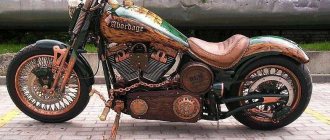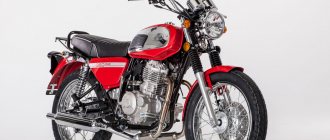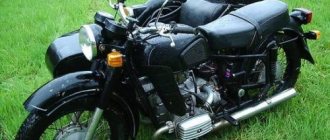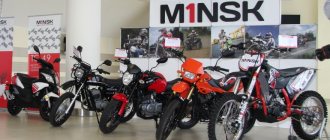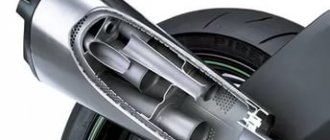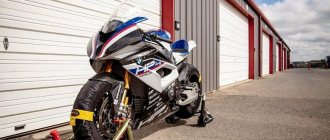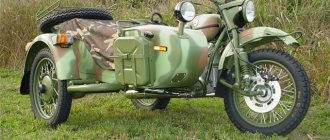- Classification of jet skis
- Jet ski device
- Operating principle of jet skis
- Advantages of BRP jet skis
- Varieties
- Selection by parameters
- Models for Beginners
- Choosing a used jet ski
- Infographics
“Hydrocycle”/“aquabike”/“jet ski” is the name of the same type of water equipment; it is a complex technical device designed for movement on water, which, due to its external similarity, is often called a jet ski. According to the GIMS classification, this is a “small vessel”. Once upon a time, jet skis were used only in sports competitions, but today they are increasingly found in places where active water recreation is developed. A hydrocycle, as a watercraft, is a metal-plastic body with an internal combustion engine and a water-jet propulsion system. To understand how a jet ski works, you need to understand its main types.
Classification of jet skis
“Stand-up” jet skis are not easy to operate and require certain sports skills. They reach speeds of up to 120 km/h. These jet skis are usually ridden by freestylers who can make spectacular turns and jumps. On such models you can always adjust the inclination of the water cannon nozzle, adjusting it for each trick.
“Sedentary” - designed for long boat trips. Designed for active recreation on the watery expanses of large reservoirs and rivers. Sit-on jet skis come in two-seater and three-seater versions. And although they are inferior in power and maneuverability to stand-up jet skis, they are also used to tow water skiers, inflatable balloons and cheesecakes.
If you need a jet ski for yourself to enjoy on the water, pay attention to the sit-on models. Standing ones are recommended for experienced athletes.
Aquabike racing
The fashion for motorcycle water crossings appeared as soon as the first bike hit the water. At first they were primitive, but soon gained admirers. Some rules were created, and from time to time in cities along the river, lake, or sea, screaming crowds of fans and spectacle-goers lined up. Jet ski racing turned into a real racing fever, which had all the necessary attributes: rules, clubs, associations, betting.
Amateur competitions have grown into a sports discipline under the supervision of the International Sports Union and the International Water Sports Association (abbreviations of the organizations UIM and IJSBA, respectively). Gradually, several major competitions appeared on the world stage, in which anyone could take part. So, the most rated competitions are:
- Pro Watercross Tour;
- European Championships;
- Championships of individual countries;
- World championships in aquabike in three classes.
It is worth noting that most major sporting events in aquabike include in their program, in addition to the main competitive part, an extensive entertainment program for spectators.
Jet ski device
- A body that can be made of high-strength plastics and other polymer materials, reinforced with metal inserts. The shape of the jet ski allows it to be maneuverable and quite easy to control. The case also has an insulated compartment for things that can be protected from water ingress.
- The engine is reliably protected from water. It is located inside the body of the jet ski and is the heart of this device.
- Cooling system (it can be closed or open type).
- Steering system (determines the direction of movement of the jetski). Taxiing is carried out by changing the horizontal angle of the water jet. The turning radius also depends on how sharply the driver turns the steering wheel.
- Additional technical devices. Driving a jet ski today can be more comfortable than, for example, 10 years ago. Many models have navigation, echo sounder, rear view mirrors and even water braking.
Jet skis are often used in regions where there is sea, lakes, rivers and other large bodies of water. It is not recommended to drive along narrow rivers with rock rapids, as this can lead to injury. The scope of application of jet skis is presented:
- boat excursions to the sea or by the lake - this is an excellent opportunity to have a “breezy” ride; usually the vacationer sits in the passenger seat and is taken for a ride by an experienced driver;
- independent walks along reservoirs - from the water you can look at beautiful landscapes from a different perspective;
- domestic sphere - jet skis can be used for fishing and in the household, for example, for transporting small loads.
- sports competitions - athletes compete with each other both at the regional and international levels;
Competition rules
Every organized event is not complete without firm principles called “Rules”. In relation to aquasports, they are being developed by the Federation of Water-Motor Sports of Russia (hereinafter referred to as FWMS). Let's look at some excerpts regarding aquabike competitions.
Terminology
The rules provide for the use of special terminology.
- “Sports boat” is a device for moving on water. The driver of the vehicle has complete control over its speed and direction of movement. In terms of engine displacement, it belongs to the class of water motorcycles (aquabikes, jet skis) - vehicles with permanently installed internal combustion engines. A water jet operates as a propulsion force.
- A “sports motor” is a mechanism that produces energy to propel a vehicle. Consists of a power source, ignition, gas distribution, cooling system.
- “Engine displacement” is the sum of the volumes of all cylinders in working condition.
Knowledge of special terminology allows the athlete to correctly implement technical actions and correctly interpret the requirements prescribed in the Aquabike Rules.
Types and nature of competitions
In 1990, the first city Cups began to be held in Russia. Already in 2000, they acquired All-Russian status, attracting more and more fans. Every major water city has its own jetski club. The Russian national team is no exception, and is a regular participant in major competitive events, such as:
- International - a sporting event included in the UIM calendar, held among license holders of national federations.
- National – for participants with a FVMS license. The event is included in the Federation’s sports calendar.
- All-Russian - takes place according to the Unified calendar plan of the Ministry of Sports and Tourism of Russia.
In closed competitions, participants from individual clubs or territories compete. However, everyone can take part in the open ones, freely demonstrating their skills in taming the iron beast.
Aquabike competitions are held in three disciplines:
- Circuit racing is a 12-15 turn race with red (right) and white (left) buoys. The first one to cross the race track wins.
- Slalom is a spectacular race on a marked rectangle, inside of which there are red buoys that can be overcome against the clock.
- Freestyle is a free program in which various flips and tricks are demonstrated. Some elements are included in the mandatory competition program. Freestyle is the most spectacular and is loved by the audience. Diving and jumping out of the water, turns and other tricks can cause nothing but amazement and delight of the public.
Correspondence of the aquabike class to a specific sports discipline
| № | Jetski class | Discipline |
| 1 | Runabout GP3 | Circuit racing |
| 2 | Runabout GP2 | |
| 3 | Runabout GP1 | |
| 4 | Ski Division GP3 | |
| 5 | Ski Division GP2 | |
| 6 | Ski Division GP1 | |
| 7 | Runabout GP2 | Rally raid |
| 8 | Runabout GP1 | |
| 9 | Ski Division GP1 | |
| 10 | Ski Division GP1 | Slalom |
| 11 | Runabout GP1 |
When analyzing the data in the table, we can conclude that each sports discipline corresponds to a certain class of aquabike.
Operating principle of jet skis
The engine of a modern jet ski starts only if a special key is inserted into the lock, which is attached with a flexible cord to the life jacket of the person driving. This principle is intended to ensure safety and emergency engine shutdown. In case of possible fall of the helmsman, the key will be automatically pulled out and the engine will stop working. This reduces the risk of an uncontrolled watercraft colliding with another vessel or with an obstacle at high speed.
Neutral and reverse gears
To engage neutral, first shift into reverse and then push the lever back until the watercraft stops. The reverse flap will be in the middle position, throwing part of the water flow towards the front of the watercraft, thereby reducing its speed.
Warning
Never use jet propulsion components as a support point when lifting aboard a watercraft. Operate the shift lever only when the engine is idling and the watercraft has come to a complete stop. When reversing, never increase engine speed. Do not use reverse gear to stop the watercraft. If possible, drive in reverse for short periods of time and at low speeds. Always make sure there are no obstacles or people behind you, especially children playing in shallow water.
Advantages of BRP jet skis
BRP jet skis have been on the market for over 50 years, since 1968. This company has always been ahead of its competitors and was the first to introduce to the world a jet ski model with a four-stroke engine. BRP was also the first to present a jet ski with an engine of more than 200 horsepower. They could accelerate faster and outpaced their predecessors in top speed.
Subsequently, other manufacturers of jet skis took advantage of BRP’s developments and implemented these solutions in their devices. But some advantages of BRP still remain unique:
- OTAS - an electronic system that affects taxiing on the water;
- iBR is a modern braking system.
BRP influences the decisions of all jetski manufacturers and sets leading trends in the industry. All BRP models are characterized by:
- reliability (BRP jet skis use only high-quality parts that do not fail for a long time; they also require regular maintenance);
- affordable price (in terms of price-quality ratio, BRP jetskis have become market leaders, they have surpassed their competitors and have reached the point where they can independently set current trends);
- intelligent gas supply control system;
- 60-liter fuel tank;
- dry weight about 400 kg;
- unpretentiousness in maintenance (this is facilitated by the simple design of the engine and housing).
Among the offers from the manufacturer BRP there are both amateur models suitable for beginners and sports jet skis designed for experienced jet ski drivers and competitions at a professional level.
Operating principle
The operating principle of a modern jet ski is very similar to household devices - a lawn mower, a chainsaw. Jet skis operate on two- or four-stroke engines. The power unit of the first version of the jet ski is equipped with two or three cylinders, the second version of the vehicle is usually equipped with four cylinders. The main difference from ground transport is the unique cooling system. Engine temperature control is ensured by supplying cold water directly from the reservoir.
The principle of starting a jet ski is similar. Its mechanism is activated by the ignition button, which is located directly on the steering wheel. How does a jet ski work? It's simple - the ignition button activates the starter, which, in turn, rotates the crankshaft and actually starts the power unit itself.
Types of BRP jet skis
All jetskis can also be divided into: amateur, family and sports. There are also luxury models that are characterized by the presence of the most modern technical equipment. The most popular models include:
- Sea-DooSpark is a jet ski designed for the whole family. It was developed over 7 years, and then tested for three years. The model presented on the market today has already received various awards around the world both for its characteristics and design. There are 2-seater and 3-seater jet skis. They are easy to operate, and fuel consumption is very economical - only 8 liters per 100 km. This water scooter weighs 165 kg (for 2 seats) and 205 kg (for 3 seats).
- The Sea-Doo GTX Limited 300 is a top-of-the-line luxury model with 300 horsepower. The seat here is very comfortable, it follows the natural curves of the body. “Luxury” is represented by additions in the form of a waterproof bag, a USB port and a special case. The manufacturer also made sure that there were sensors that determine the water temperature and the depth at which the water vehicle is currently located. This model features an exclusive bright color. Many people choose this jet ski for water trips to use the removable seat: it can be folded out, and then there will be enough space on the jet ski to sunbathe in the middle of open water.
- The GTI 90 is a budget model that BRP released in 2020. Despite its novelty, it quickly became a favorite among other proposals. 90 “horses” are more than enough to move with pleasure in both fresh and salt water. The body of the aquabike is made of polytec material, it is scratch-resistant. There is also an ITC system on board that helps control the gas supply depending on the situation. There are three modes: Touring, Eco and Sport. The jet ski is equipped with a modern IBR braking system, which allows you to quickly reduce speed in any conditions. There is a special trunk for things with a compartment protected from moisture.
Problems of development of sports discipline in the Russian Federation
The promotion of fashionable water sports in Europe and the world faces some problems related to the mentality of the nation.
- An important role is played by the opinion that in a country where a high percentage of the population lives below the poverty line, it is inappropriate to spend budget funds on a relatively expensive sport. In this regard, aquabike is unlikely to become “popular”, like football and hockey.
- There is an opinion that it is necessary to develop traditional species, that foreign things do not contribute to the revival of Russia.
- the sport is seen as elite and not suitable for the general population.
- Poor coverage of events related to jetskis in the press. This is due to the seasonality of events.
Despite all the difficulties, on June 16, 2000, aquabiker day was held for the first time. Since then, the holiday has become traditional and beloved not only among racers, but also among spectators.
How to choose a jet ski based on parameters?
- Engine power. It will determine what speed the jet ski will develop and how sharply it can maneuver.
- Technical equipment. Braking, control systems and other features affect the driving characteristics of the vehicle.
- Case quality. It must be made of durable and damage-resistant materials.
- The presence of a box protected from moisture. It should fit everything you need and valuable (money, phone, documents).
- Seat ergonomics. They should be comfortable and safe to sit on.
- Design. By purchasing luxury models, you can choose how stylish your watercraft will be. Pay attention to color, shape and other features.
Having decided on the budget and the purpose for which the jet ski will be used, you can proceed to get acquainted with the BRP models according to the main parameters.
Competition procedure
The competition rules clearly define the stages of their preparation and conduct. The key ones are:
- Conducting a daily briefing by the panel of judges.
- Consideration of the features of the starting procedure.
- Carrying out a restart if the competition is stopped by a judge.
- Consideration of issues related to a false start of a race (restart).
- Rules for driving on the highway.
- Passing turning buoys, overtaking and connection rules.
- Finishing order.
- Consideration of signaling equipment and signals required to control competitions.
- Procedure for determining the winner.
In addition to the main points, the Rules also provide additional ones, which are aimed at conducting the most fair and fair competitions in relation to each participant in the races.
Aquabike models for beginners
A novice driver can opt for the GTI 90 from BRP, which is powerful and maneuverable enough for cruising the waters. This jet ski is not suitable for professional athletes who want to hone their skills in graceful tricks.
Another option is the Spark Trixx 2UP two-seater jet ski. It accelerates to 77 km/h with an engine power of 90 hp. This vehicle is distinguished by its affordable price (it is significantly cheaper than more advanced models) and excellent quality. Here you can adjust the steering wheel height, which provides additional convenience. The jet ski is equipped with a water jet control system and a foot rest at the stern.
Tips for buying a used jet ski
It is best to buy used jet skis from trusted dealers - this will allow you to save significant amounts and, if necessary, replace jet skis more often. After all, even if it has been in use for only a few months, its price has already dropped significantly.
There are many details to consider when choosing a jet ski. Looking through the catalog of offers from well-known manufacturers, you can make your choice in favor of a fast and maneuverable aquabike, which will become an indispensable companion on boat trips.
Steering
The steering movements are transmitted to the water jet nozzle, which controls the direction of movement of the jet ski. By turning the steering wheel to the right, the jet ski will turn to the right and vice versa. To make a turn, you must press the accelerator lever.
Warning
To turn a jet ski, you need to turn the steering wheel and press the accelerator lever. Handling depends on the number of passengers, load, water conditions and environmental factors such as wind. Unlike a car, to turn a jet ski you need to press the accelerator lever. Practice making turns in a safe environment. This will help you avoid an accident.
When the throttle is released and the engine is stopped, steering efficiency is reduced. Operating a jet ski with a passenger is different from driving alone and requires better riding skills. The passenger should always hold onto the seat belt or grab handle. Reduce speed and avoid sharp turns. When driving with a passenger, avoid choppy waters.
The Passive Passive Steering System (OPAS) uses two side flaps to assist in turning the watercraft when the steering wheel is turned while the throttle is released or the engine is stopped. The side flaps, located at the rear of the hull, rotate in the same direction as the steering wheel, making it easier to control the jet ski. Become familiar with the operation of this system carefully before using it.
When the engine is running at 75% of the rated speed, the side flaps are automatically raised as they are not needed at that speed. When the engine is operating at a frequency of 30-75% of the rated speed, the side flaps are partially raised. Side flaps in up position. When the accelerator lever is released and the engine speed drops, the side flaps automatically lower and make it easier to control the jet ski.



